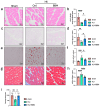Berbamine Promotes the Repair of Lower Limb Muscle Damage in Chronic Limb-Threatening Ischemia by Inhibiting Local Inflammation and NF-κB Nuclear Translocation
- PMID: 39770425
- PMCID: PMC11679954
- DOI: 10.3390/ph17121583
Berbamine Promotes the Repair of Lower Limb Muscle Damage in Chronic Limb-Threatening Ischemia by Inhibiting Local Inflammation and NF-κB Nuclear Translocation
Abstract
Background/Objectives: Chronic Limb-Threatening Ischemia (CLTI) is a chronic limb ischemic disease caused by vascular lesions, characterized by pain, ulcers, and gangrene, which can be life-threatening in severe cases. The objective of this study is to explore whether Berbamine (BBM) can protect against and repair ischemic muscle tissue in the lower limbs; Methods: Using a mouse hindlimb ischemia (HLI) model, 36 C57BL6 mice were divided into sham, HLI, and HLI+BBM treatment groups. Results: Our findings indicate that BBM can restore motor function and muscle tissue pathology in mice, potentially by inhibiting the nuclear translocation of nuclear factor kappa-B (NF-κB), thereby alleviating tissue inflammation caused by chronic ischemia, reducing muscle cell apoptosis, inhibiting M1 macrophage polarization, and promoting angiogenesis. Conclusions: Our research suggests that BBM has the potential to protect against ischemic damage in lower limb muscle tissue, providing a new approach to the treatment of CLTI.
Keywords: apoptosis; berbamine; inflammation; limb ischemia; nuclear factor kappa-B.
Conflict of interest statement
The authors declare no conflicts of interest.
Figures





Similar articles
-
Berbamine attenuates hind limb ischemia-reperfusion injury by eliminating lipid ROS and inhibiting p65 nuclear translocation.Front Pharmacol. 2025 Mar 11;16:1509860. doi: 10.3389/fphar.2025.1509860. eCollection 2025. Front Pharmacol. 2025. PMID: 40135236 Free PMC article.
-
PER1 promotes functional recovery of mice with hindlimb ischemia by inducing anti-inflammatory macrophage polarization.Biochem Biophys Res Commun. 2023 Feb 12;644:62-69. doi: 10.1016/j.bbrc.2023.01.001. Epub 2023 Jan 2. Biochem Biophys Res Commun. 2023. PMID: 36634583
-
Skeletal muscle regeneration failure in ischemic-damaged limbs is associated with pro-inflammatory macrophages and premature differentiation of satellite cells.Genome Med. 2023 Nov 10;15(1):95. doi: 10.1186/s13073-023-01250-y. Genome Med. 2023. PMID: 37950327 Free PMC article.
-
Global vascular guidelines on the management of chronic limb-threatening ischemia.J Vasc Surg. 2019 Jun;69(6S):3S-125S.e40. doi: 10.1016/j.jvs.2019.02.016. Epub 2019 May 28. J Vasc Surg. 2019. PMID: 31159978 Free PMC article.
-
Mesenchymal stem cell-based therapy for non-healing wounds due to chronic limb-threatening ischemia: A review of preclinical and clinical studies.Front Cardiovasc Med. 2023 Feb 1;10:1113982. doi: 10.3389/fcvm.2023.1113982. eCollection 2023. Front Cardiovasc Med. 2023. PMID: 36818343 Free PMC article. Review.
References
-
- Conte M.S., Bradbury A.W., Kolh P., White J.V., Dick F., Fitridge R., Mills J.L., Ricco J.B., Suresh K.R., Murad M.H., et al. Global Vascular Guidelines on the Management of Chronic Limb-Threatening Ischemia. Eur. J. Vasc. Endovasc. Surg. 2019;58:S1–S109.e33. doi: 10.1016/j.ejvs.2019.05.006. - DOI - PMC - PubMed
-
- Furubeppu H., Ito T., Kakuuchi M., Yasuda T., Kamikokuryo C., Yamada S., Maruyama I., Kakihana Y. Differential Regulation of Damage-Associated Molecular Pattern Release in a Mouse Model of Skeletal Muscle Ischemia/Reperfusion Injury. Front. Immunol. 2021;12:628822. doi: 10.3389/fimmu.2021.628822. - DOI - PMC - PubMed
Grants and funding
LinkOut - more resources
Full Text Sources

